PROJ6000: Project Selection Methods and PID for Uber Project
VerifiedAdded on 2022/11/18
|11
|2538
|454
Report
AI Summary
This report examines project selection methods and project initiation documents (PID) within the context of the Uber case study. It explores the application of the Benefit Measurement method, aligning with the Project Management Body of Knowledge (PMBOK) framework, to the development of Uber's new driver application. The report details the selection process, emphasizing the importance of considering driver feedback and the project's alignment with organizational goals. It also outlines the project's initiation documents, including project goals, size, organization, limitations, risks, and stakeholders, providing a comprehensive overview of the project's structure and objectives. The analysis highlights the company's strategic approach to project management, aiming to enhance driver satisfaction and improve the application's functionality, ultimately contributing to the company's success in the gig economy.
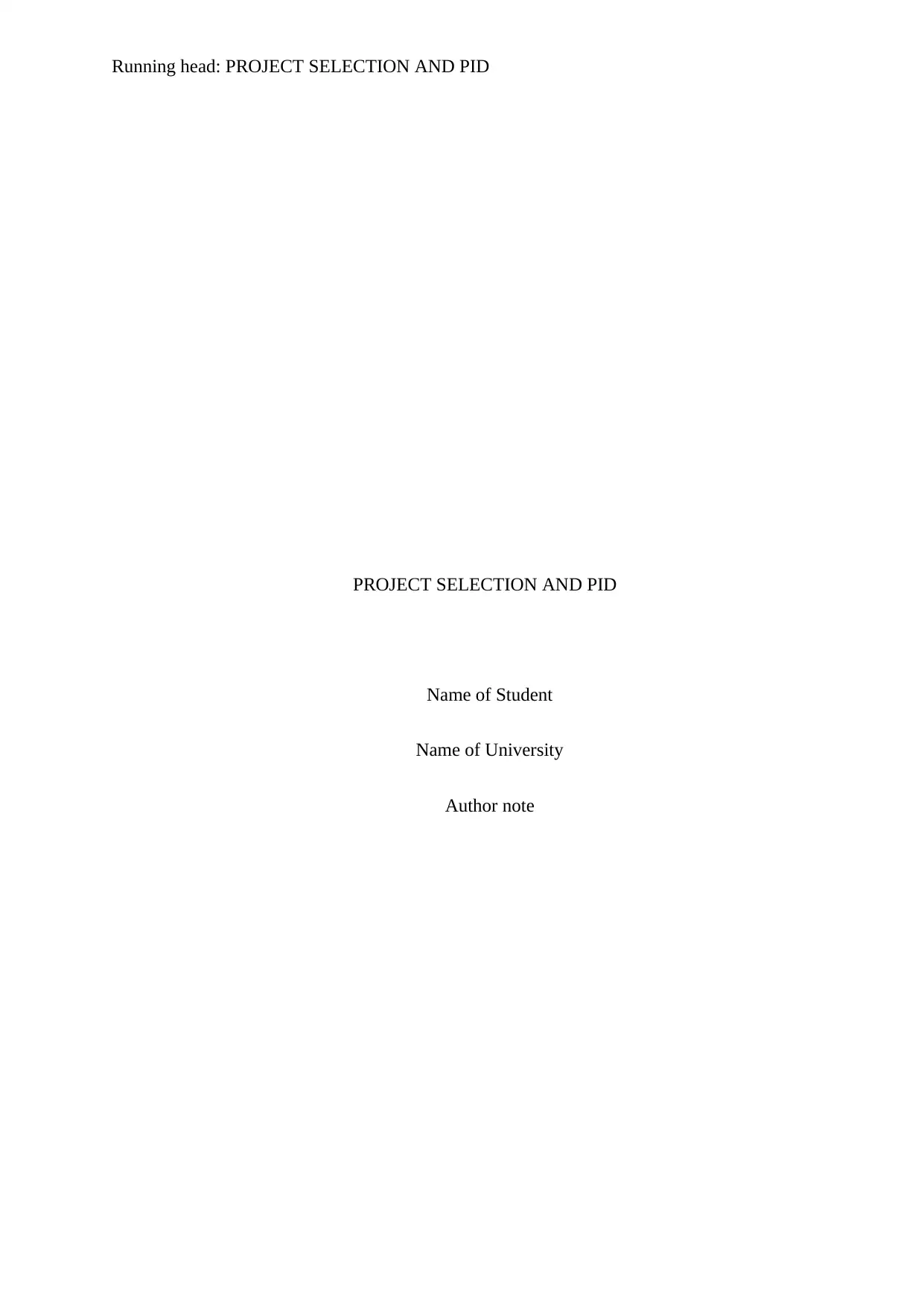
Running head: PROJECT SELECTION AND PID
PROJECT SELECTION AND PID
Name of Student
Name of University
Author note
PROJECT SELECTION AND PID
Name of Student
Name of University
Author note
Paraphrase This Document
Need a fresh take? Get an instant paraphrase of this document with our AI Paraphraser
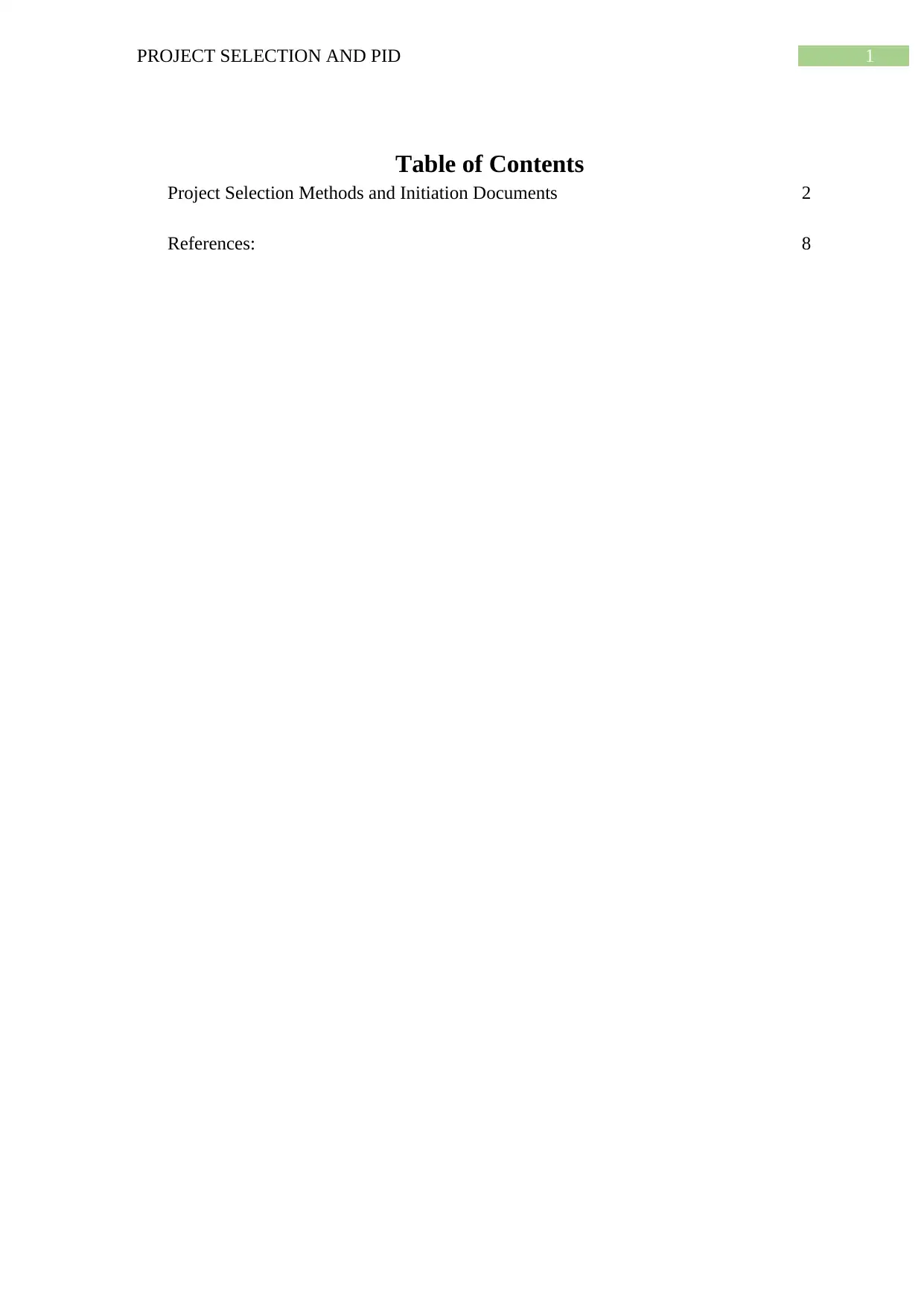
1PROJECT SELECTION AND PID
Table of Contents
Project Selection Methods and Initiation Documents 2
References: 8
Table of Contents
Project Selection Methods and Initiation Documents 2
References: 8
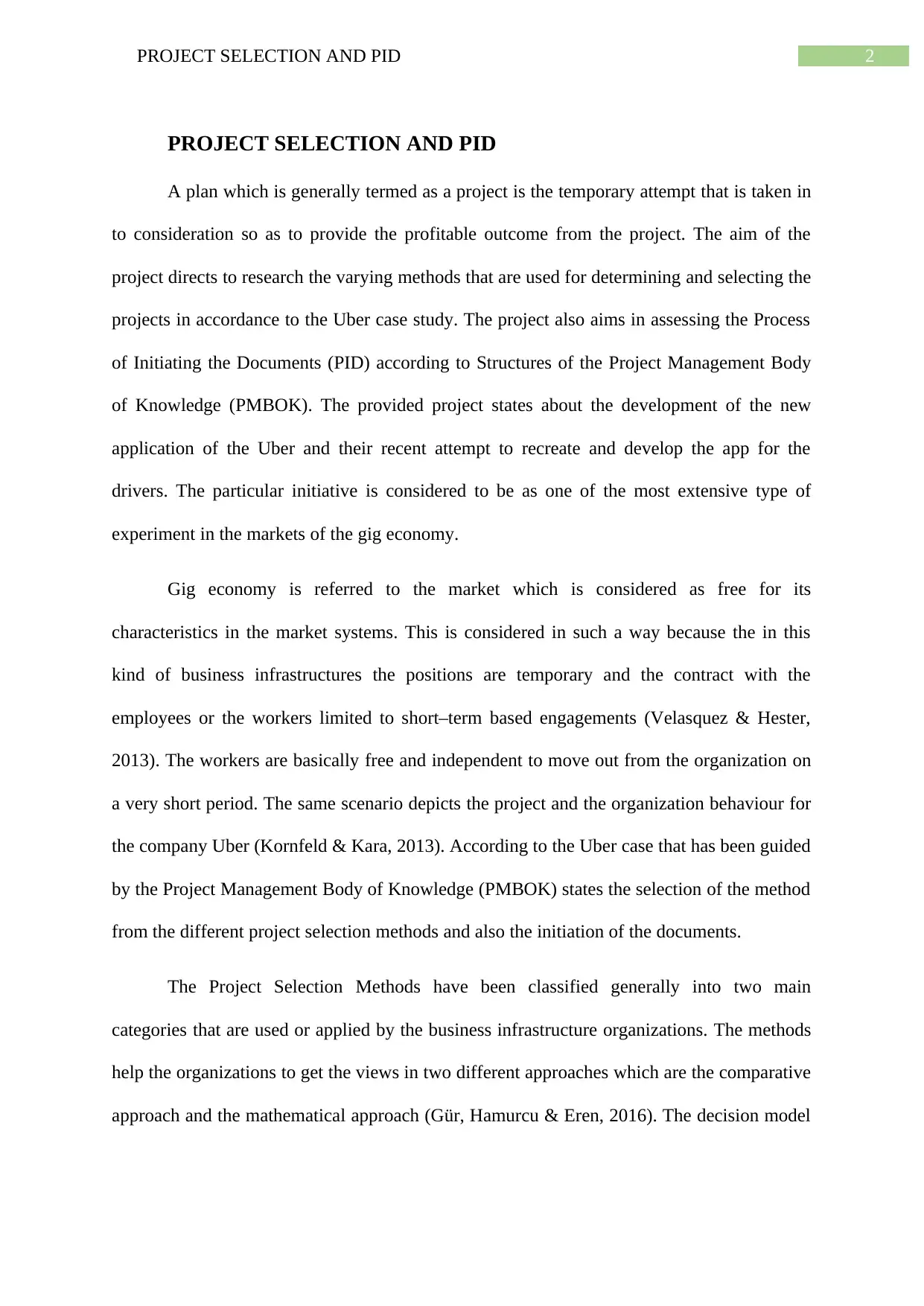
2PROJECT SELECTION AND PID
PROJECT SELECTION AND PID
A plan which is generally termed as a project is the temporary attempt that is taken in
to consideration so as to provide the profitable outcome from the project. The aim of the
project directs to research the varying methods that are used for determining and selecting the
projects in accordance to the Uber case study. The project also aims in assessing the Process
of Initiating the Documents (PID) according to Structures of the Project Management Body
of Knowledge (PMBOK). The provided project states about the development of the new
application of the Uber and their recent attempt to recreate and develop the app for the
drivers. The particular initiative is considered to be as one of the most extensive type of
experiment in the markets of the gig economy.
Gig economy is referred to the market which is considered as free for its
characteristics in the market systems. This is considered in such a way because the in this
kind of business infrastructures the positions are temporary and the contract with the
employees or the workers limited to short–term based engagements (Velasquez & Hester,
2013). The workers are basically free and independent to move out from the organization on
a very short period. The same scenario depicts the project and the organization behaviour for
the company Uber (Kornfeld & Kara, 2013). According to the Uber case that has been guided
by the Project Management Body of Knowledge (PMBOK) states the selection of the method
from the different project selection methods and also the initiation of the documents.
The Project Selection Methods have been classified generally into two main
categories that are used or applied by the business infrastructure organizations. The methods
help the organizations to get the views in two different approaches which are the comparative
approach and the mathematical approach (Gür, Hamurcu & Eren, 2016). The decision model
PROJECT SELECTION AND PID
A plan which is generally termed as a project is the temporary attempt that is taken in
to consideration so as to provide the profitable outcome from the project. The aim of the
project directs to research the varying methods that are used for determining and selecting the
projects in accordance to the Uber case study. The project also aims in assessing the Process
of Initiating the Documents (PID) according to Structures of the Project Management Body
of Knowledge (PMBOK). The provided project states about the development of the new
application of the Uber and their recent attempt to recreate and develop the app for the
drivers. The particular initiative is considered to be as one of the most extensive type of
experiment in the markets of the gig economy.
Gig economy is referred to the market which is considered as free for its
characteristics in the market systems. This is considered in such a way because the in this
kind of business infrastructures the positions are temporary and the contract with the
employees or the workers limited to short–term based engagements (Velasquez & Hester,
2013). The workers are basically free and independent to move out from the organization on
a very short period. The same scenario depicts the project and the organization behaviour for
the company Uber (Kornfeld & Kara, 2013). According to the Uber case that has been guided
by the Project Management Body of Knowledge (PMBOK) states the selection of the method
from the different project selection methods and also the initiation of the documents.
The Project Selection Methods have been classified generally into two main
categories that are used or applied by the business infrastructure organizations. The methods
help the organizations to get the views in two different approaches which are the comparative
approach and the mathematical approach (Gür, Hamurcu & Eren, 2016). The decision model
⊘ This is a preview!⊘
Do you want full access?
Subscribe today to unlock all pages.

Trusted by 1+ million students worldwide
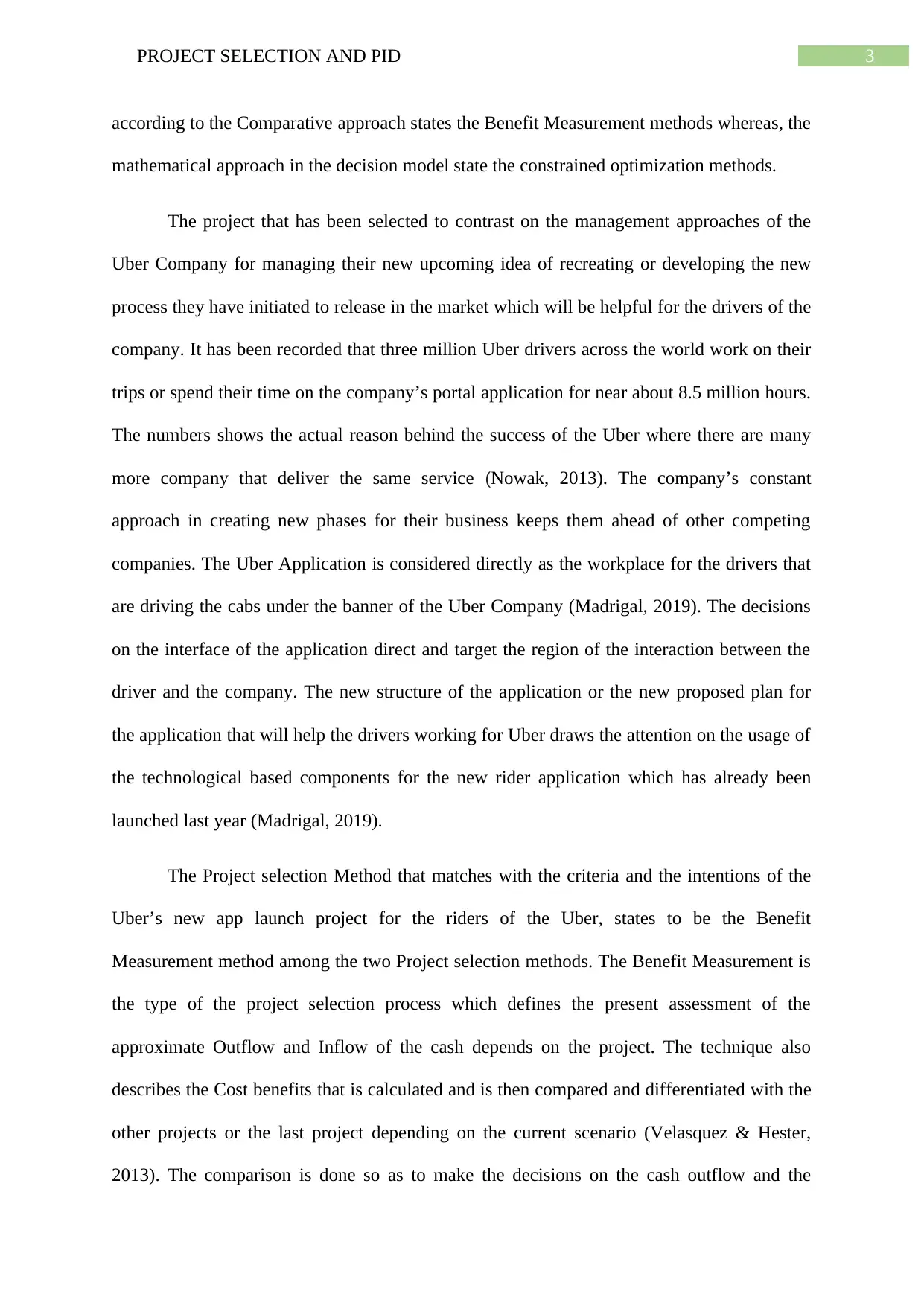
3PROJECT SELECTION AND PID
according to the Comparative approach states the Benefit Measurement methods whereas, the
mathematical approach in the decision model state the constrained optimization methods.
The project that has been selected to contrast on the management approaches of the
Uber Company for managing their new upcoming idea of recreating or developing the new
process they have initiated to release in the market which will be helpful for the drivers of the
company. It has been recorded that three million Uber drivers across the world work on their
trips or spend their time on the company’s portal application for near about 8.5 million hours.
The numbers shows the actual reason behind the success of the Uber where there are many
more company that deliver the same service (Nowak, 2013). The company’s constant
approach in creating new phases for their business keeps them ahead of other competing
companies. The Uber Application is considered directly as the workplace for the drivers that
are driving the cabs under the banner of the Uber Company (Madrigal, 2019). The decisions
on the interface of the application direct and target the region of the interaction between the
driver and the company. The new structure of the application or the new proposed plan for
the application that will help the drivers working for Uber draws the attention on the usage of
the technological based components for the new rider application which has already been
launched last year (Madrigal, 2019).
The Project selection Method that matches with the criteria and the intentions of the
Uber’s new app launch project for the riders of the Uber, states to be the Benefit
Measurement method among the two Project selection methods. The Benefit Measurement is
the type of the project selection process which defines the present assessment of the
approximate Outflow and Inflow of the cash depends on the project. The technique also
describes the Cost benefits that is calculated and is then compared and differentiated with the
other projects or the last project depending on the current scenario (Velasquez & Hester,
2013). The comparison is done so as to make the decisions on the cash outflow and the
according to the Comparative approach states the Benefit Measurement methods whereas, the
mathematical approach in the decision model state the constrained optimization methods.
The project that has been selected to contrast on the management approaches of the
Uber Company for managing their new upcoming idea of recreating or developing the new
process they have initiated to release in the market which will be helpful for the drivers of the
company. It has been recorded that three million Uber drivers across the world work on their
trips or spend their time on the company’s portal application for near about 8.5 million hours.
The numbers shows the actual reason behind the success of the Uber where there are many
more company that deliver the same service (Nowak, 2013). The company’s constant
approach in creating new phases for their business keeps them ahead of other competing
companies. The Uber Application is considered directly as the workplace for the drivers that
are driving the cabs under the banner of the Uber Company (Madrigal, 2019). The decisions
on the interface of the application direct and target the region of the interaction between the
driver and the company. The new structure of the application or the new proposed plan for
the application that will help the drivers working for Uber draws the attention on the usage of
the technological based components for the new rider application which has already been
launched last year (Madrigal, 2019).
The Project selection Method that matches with the criteria and the intentions of the
Uber’s new app launch project for the riders of the Uber, states to be the Benefit
Measurement method among the two Project selection methods. The Benefit Measurement is
the type of the project selection process which defines the present assessment of the
approximate Outflow and Inflow of the cash depends on the project. The technique also
describes the Cost benefits that is calculated and is then compared and differentiated with the
other projects or the last project depending on the current scenario (Velasquez & Hester,
2013). The comparison is done so as to make the decisions on the cash outflow and the
Paraphrase This Document
Need a fresh take? Get an instant paraphrase of this document with our AI Paraphraser
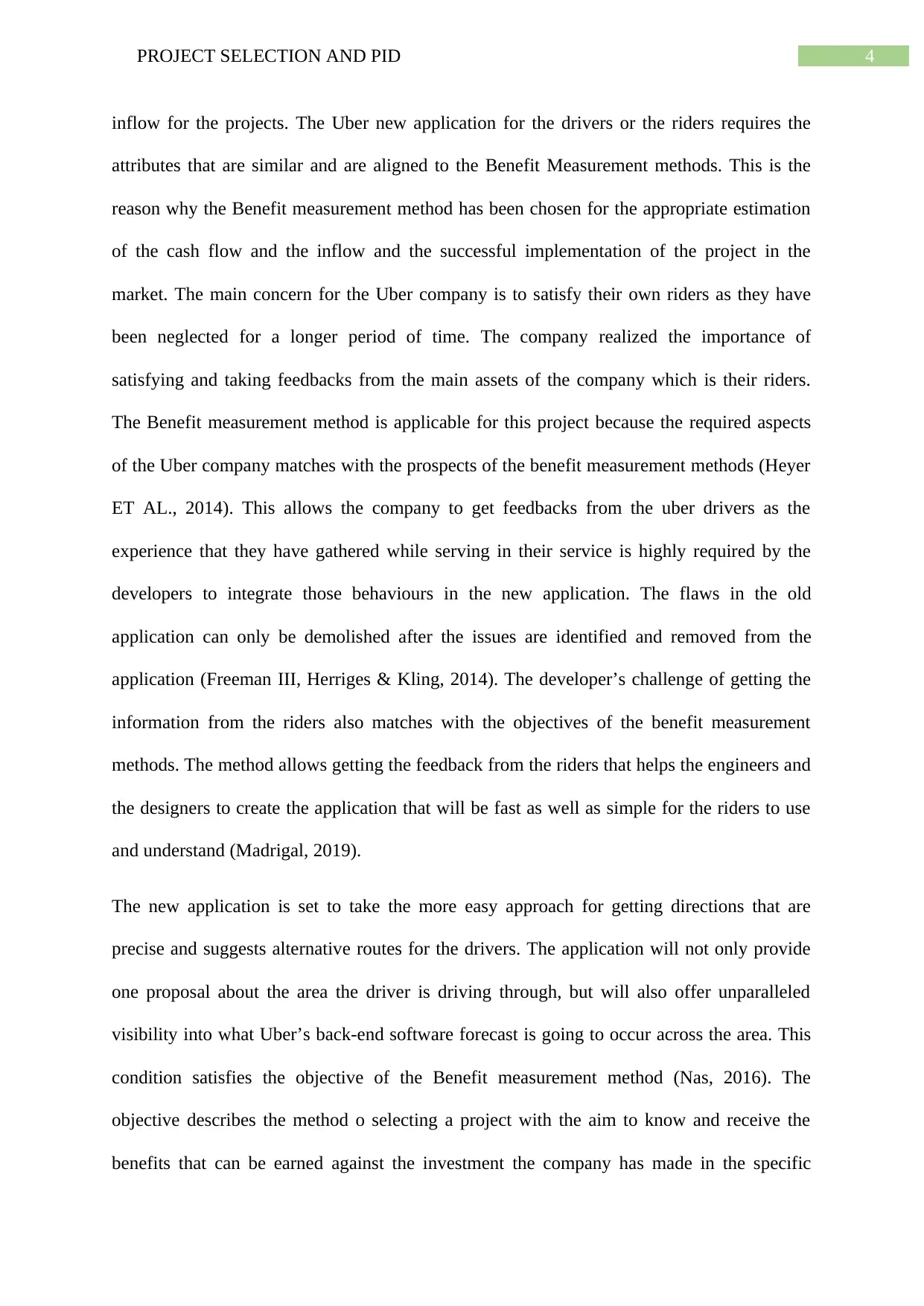
4PROJECT SELECTION AND PID
inflow for the projects. The Uber new application for the drivers or the riders requires the
attributes that are similar and are aligned to the Benefit Measurement methods. This is the
reason why the Benefit measurement method has been chosen for the appropriate estimation
of the cash flow and the inflow and the successful implementation of the project in the
market. The main concern for the Uber company is to satisfy their own riders as they have
been neglected for a longer period of time. The company realized the importance of
satisfying and taking feedbacks from the main assets of the company which is their riders.
The Benefit measurement method is applicable for this project because the required aspects
of the Uber company matches with the prospects of the benefit measurement methods (Heyer
ET AL., 2014). This allows the company to get feedbacks from the uber drivers as the
experience that they have gathered while serving in their service is highly required by the
developers to integrate those behaviours in the new application. The flaws in the old
application can only be demolished after the issues are identified and removed from the
application (Freeman III, Herriges & Kling, 2014). The developer’s challenge of getting the
information from the riders also matches with the objectives of the benefit measurement
methods. The method allows getting the feedback from the riders that helps the engineers and
the designers to create the application that will be fast as well as simple for the riders to use
and understand (Madrigal, 2019).
The new application is set to take the more easy approach for getting directions that are
precise and suggests alternative routes for the drivers. The application will not only provide
one proposal about the area the driver is driving through, but will also offer unparalleled
visibility into what Uber’s back-end software forecast is going to occur across the area. This
condition satisfies the objective of the Benefit measurement method (Nas, 2016). The
objective describes the method o selecting a project with the aim to know and receive the
benefits that can be earned against the investment the company has made in the specific
inflow for the projects. The Uber new application for the drivers or the riders requires the
attributes that are similar and are aligned to the Benefit Measurement methods. This is the
reason why the Benefit measurement method has been chosen for the appropriate estimation
of the cash flow and the inflow and the successful implementation of the project in the
market. The main concern for the Uber company is to satisfy their own riders as they have
been neglected for a longer period of time. The company realized the importance of
satisfying and taking feedbacks from the main assets of the company which is their riders.
The Benefit measurement method is applicable for this project because the required aspects
of the Uber company matches with the prospects of the benefit measurement methods (Heyer
ET AL., 2014). This allows the company to get feedbacks from the uber drivers as the
experience that they have gathered while serving in their service is highly required by the
developers to integrate those behaviours in the new application. The flaws in the old
application can only be demolished after the issues are identified and removed from the
application (Freeman III, Herriges & Kling, 2014). The developer’s challenge of getting the
information from the riders also matches with the objectives of the benefit measurement
methods. The method allows getting the feedback from the riders that helps the engineers and
the designers to create the application that will be fast as well as simple for the riders to use
and understand (Madrigal, 2019).
The new application is set to take the more easy approach for getting directions that are
precise and suggests alternative routes for the drivers. The application will not only provide
one proposal about the area the driver is driving through, but will also offer unparalleled
visibility into what Uber’s back-end software forecast is going to occur across the area. This
condition satisfies the objective of the Benefit measurement method (Nas, 2016). The
objective describes the method o selecting a project with the aim to know and receive the
benefits that can be earned against the investment the company has made in the specific
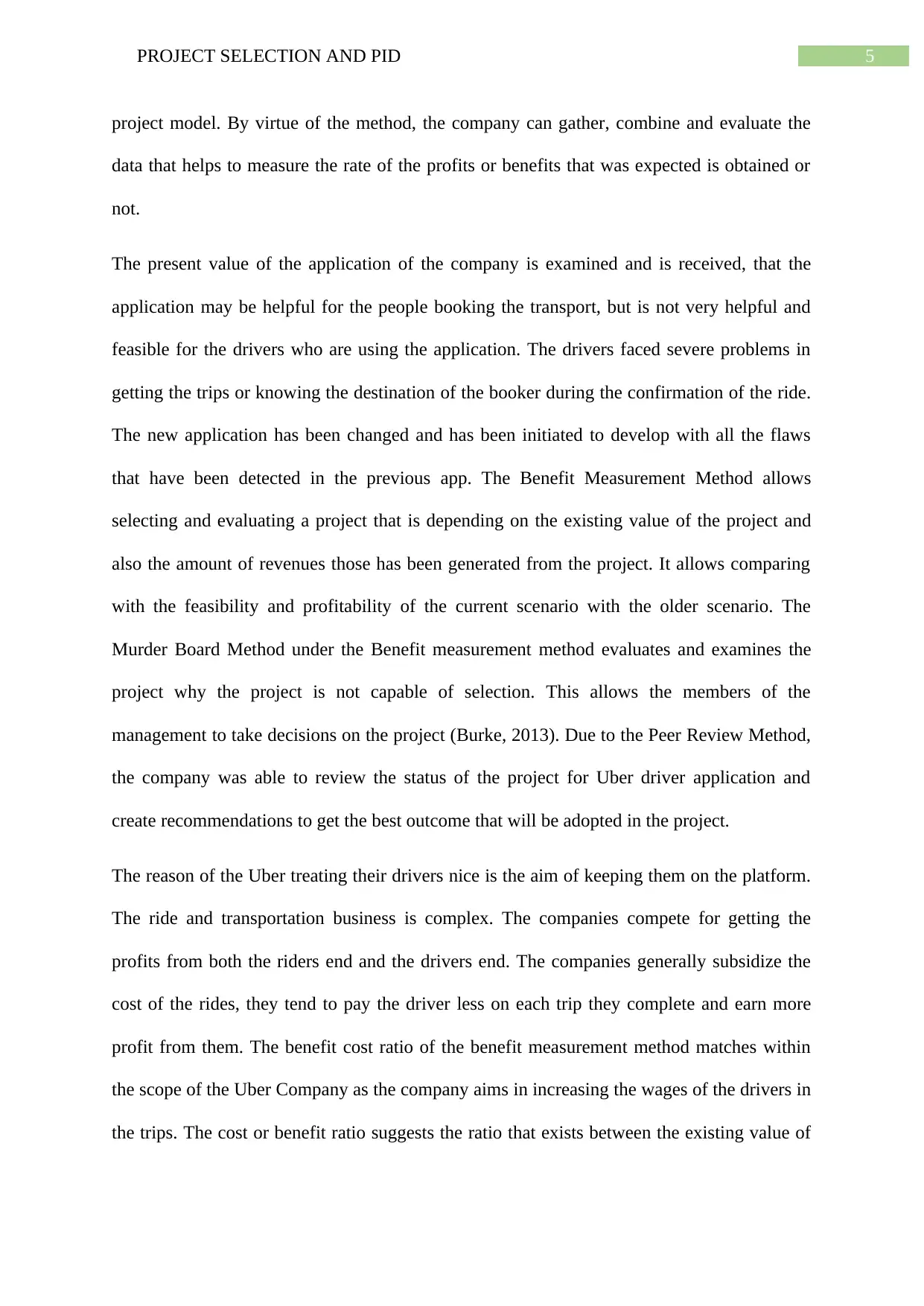
5PROJECT SELECTION AND PID
project model. By virtue of the method, the company can gather, combine and evaluate the
data that helps to measure the rate of the profits or benefits that was expected is obtained or
not.
The present value of the application of the company is examined and is received, that the
application may be helpful for the people booking the transport, but is not very helpful and
feasible for the drivers who are using the application. The drivers faced severe problems in
getting the trips or knowing the destination of the booker during the confirmation of the ride.
The new application has been changed and has been initiated to develop with all the flaws
that have been detected in the previous app. The Benefit Measurement Method allows
selecting and evaluating a project that is depending on the existing value of the project and
also the amount of revenues those has been generated from the project. It allows comparing
with the feasibility and profitability of the current scenario with the older scenario. The
Murder Board Method under the Benefit measurement method evaluates and examines the
project why the project is not capable of selection. This allows the members of the
management to take decisions on the project (Burke, 2013). Due to the Peer Review Method,
the company was able to review the status of the project for Uber driver application and
create recommendations to get the best outcome that will be adopted in the project.
The reason of the Uber treating their drivers nice is the aim of keeping them on the platform.
The ride and transportation business is complex. The companies compete for getting the
profits from both the riders end and the drivers end. The companies generally subsidize the
cost of the rides, they tend to pay the driver less on each trip they complete and earn more
profit from them. The benefit cost ratio of the benefit measurement method matches within
the scope of the Uber Company as the company aims in increasing the wages of the drivers in
the trips. The cost or benefit ratio suggests the ratio that exists between the existing value of
project model. By virtue of the method, the company can gather, combine and evaluate the
data that helps to measure the rate of the profits or benefits that was expected is obtained or
not.
The present value of the application of the company is examined and is received, that the
application may be helpful for the people booking the transport, but is not very helpful and
feasible for the drivers who are using the application. The drivers faced severe problems in
getting the trips or knowing the destination of the booker during the confirmation of the ride.
The new application has been changed and has been initiated to develop with all the flaws
that have been detected in the previous app. The Benefit Measurement Method allows
selecting and evaluating a project that is depending on the existing value of the project and
also the amount of revenues those has been generated from the project. It allows comparing
with the feasibility and profitability of the current scenario with the older scenario. The
Murder Board Method under the Benefit measurement method evaluates and examines the
project why the project is not capable of selection. This allows the members of the
management to take decisions on the project (Burke, 2013). Due to the Peer Review Method,
the company was able to review the status of the project for Uber driver application and
create recommendations to get the best outcome that will be adopted in the project.
The reason of the Uber treating their drivers nice is the aim of keeping them on the platform.
The ride and transportation business is complex. The companies compete for getting the
profits from both the riders end and the drivers end. The companies generally subsidize the
cost of the rides, they tend to pay the driver less on each trip they complete and earn more
profit from them. The benefit cost ratio of the benefit measurement method matches within
the scope of the Uber Company as the company aims in increasing the wages of the drivers in
the trips. The cost or benefit ratio suggests the ratio that exists between the existing value of
⊘ This is a preview!⊘
Do you want full access?
Subscribe today to unlock all pages.

Trusted by 1+ million students worldwide
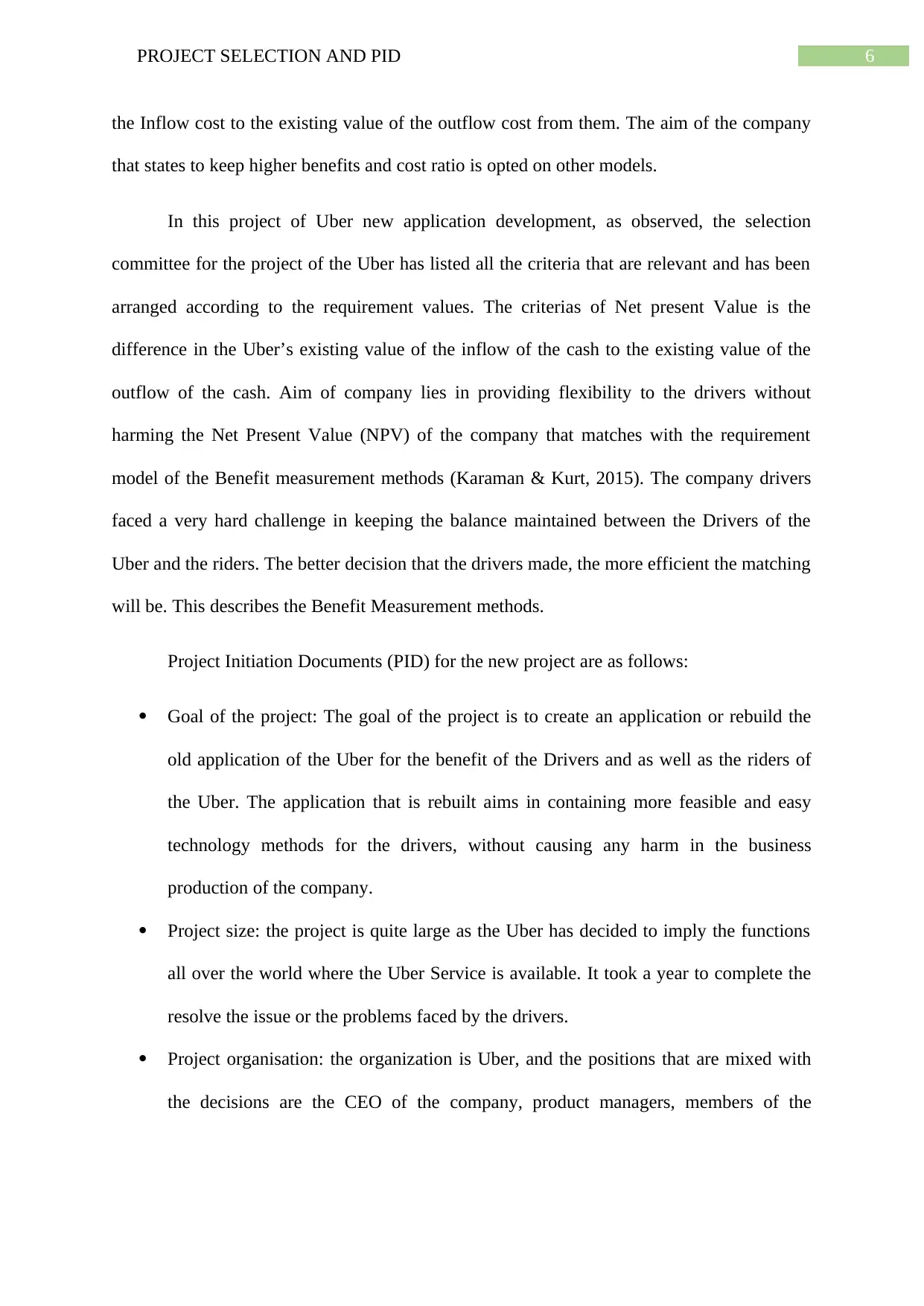
6PROJECT SELECTION AND PID
the Inflow cost to the existing value of the outflow cost from them. The aim of the company
that states to keep higher benefits and cost ratio is opted on other models.
In this project of Uber new application development, as observed, the selection
committee for the project of the Uber has listed all the criteria that are relevant and has been
arranged according to the requirement values. The criterias of Net present Value is the
difference in the Uber’s existing value of the inflow of the cash to the existing value of the
outflow of the cash. Aim of company lies in providing flexibility to the drivers without
harming the Net Present Value (NPV) of the company that matches with the requirement
model of the Benefit measurement methods (Karaman & Kurt, 2015). The company drivers
faced a very hard challenge in keeping the balance maintained between the Drivers of the
Uber and the riders. The better decision that the drivers made, the more efficient the matching
will be. This describes the Benefit Measurement methods.
Project Initiation Documents (PID) for the new project are as follows:
Goal of the project: The goal of the project is to create an application or rebuild the
old application of the Uber for the benefit of the Drivers and as well as the riders of
the Uber. The application that is rebuilt aims in containing more feasible and easy
technology methods for the drivers, without causing any harm in the business
production of the company.
Project size: the project is quite large as the Uber has decided to imply the functions
all over the world where the Uber Service is available. It took a year to complete the
resolve the issue or the problems faced by the drivers.
Project organisation: the organization is Uber, and the positions that are mixed with
the decisions are the CEO of the company, product managers, members of the
the Inflow cost to the existing value of the outflow cost from them. The aim of the company
that states to keep higher benefits and cost ratio is opted on other models.
In this project of Uber new application development, as observed, the selection
committee for the project of the Uber has listed all the criteria that are relevant and has been
arranged according to the requirement values. The criterias of Net present Value is the
difference in the Uber’s existing value of the inflow of the cash to the existing value of the
outflow of the cash. Aim of company lies in providing flexibility to the drivers without
harming the Net Present Value (NPV) of the company that matches with the requirement
model of the Benefit measurement methods (Karaman & Kurt, 2015). The company drivers
faced a very hard challenge in keeping the balance maintained between the Drivers of the
Uber and the riders. The better decision that the drivers made, the more efficient the matching
will be. This describes the Benefit Measurement methods.
Project Initiation Documents (PID) for the new project are as follows:
Goal of the project: The goal of the project is to create an application or rebuild the
old application of the Uber for the benefit of the Drivers and as well as the riders of
the Uber. The application that is rebuilt aims in containing more feasible and easy
technology methods for the drivers, without causing any harm in the business
production of the company.
Project size: the project is quite large as the Uber has decided to imply the functions
all over the world where the Uber Service is available. It took a year to complete the
resolve the issue or the problems faced by the drivers.
Project organisation: the organization is Uber, and the positions that are mixed with
the decisions are the CEO of the company, product managers, members of the
Paraphrase This Document
Need a fresh take? Get an instant paraphrase of this document with our AI Paraphraser
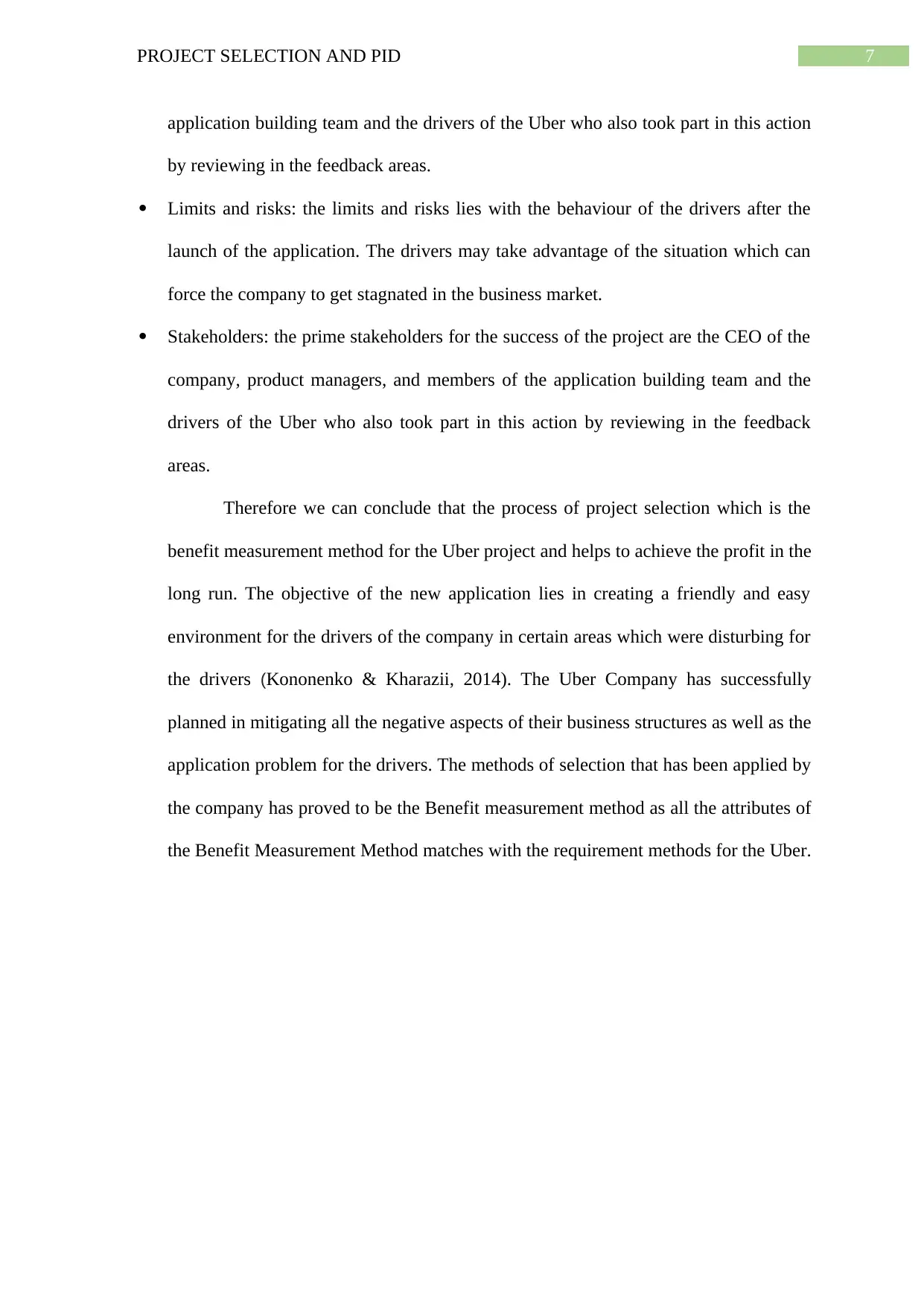
7PROJECT SELECTION AND PID
application building team and the drivers of the Uber who also took part in this action
by reviewing in the feedback areas.
Limits and risks: the limits and risks lies with the behaviour of the drivers after the
launch of the application. The drivers may take advantage of the situation which can
force the company to get stagnated in the business market.
Stakeholders: the prime stakeholders for the success of the project are the CEO of the
company, product managers, and members of the application building team and the
drivers of the Uber who also took part in this action by reviewing in the feedback
areas.
Therefore we can conclude that the process of project selection which is the
benefit measurement method for the Uber project and helps to achieve the profit in the
long run. The objective of the new application lies in creating a friendly and easy
environment for the drivers of the company in certain areas which were disturbing for
the drivers (Kononenko & Kharazii, 2014). The Uber Company has successfully
planned in mitigating all the negative aspects of their business structures as well as the
application problem for the drivers. The methods of selection that has been applied by
the company has proved to be the Benefit measurement method as all the attributes of
the Benefit Measurement Method matches with the requirement methods for the Uber.
application building team and the drivers of the Uber who also took part in this action
by reviewing in the feedback areas.
Limits and risks: the limits and risks lies with the behaviour of the drivers after the
launch of the application. The drivers may take advantage of the situation which can
force the company to get stagnated in the business market.
Stakeholders: the prime stakeholders for the success of the project are the CEO of the
company, product managers, and members of the application building team and the
drivers of the Uber who also took part in this action by reviewing in the feedback
areas.
Therefore we can conclude that the process of project selection which is the
benefit measurement method for the Uber project and helps to achieve the profit in the
long run. The objective of the new application lies in creating a friendly and easy
environment for the drivers of the company in certain areas which were disturbing for
the drivers (Kononenko & Kharazii, 2014). The Uber Company has successfully
planned in mitigating all the negative aspects of their business structures as well as the
application problem for the drivers. The methods of selection that has been applied by
the company has proved to be the Benefit measurement method as all the attributes of
the Benefit Measurement Method matches with the requirement methods for the Uber.
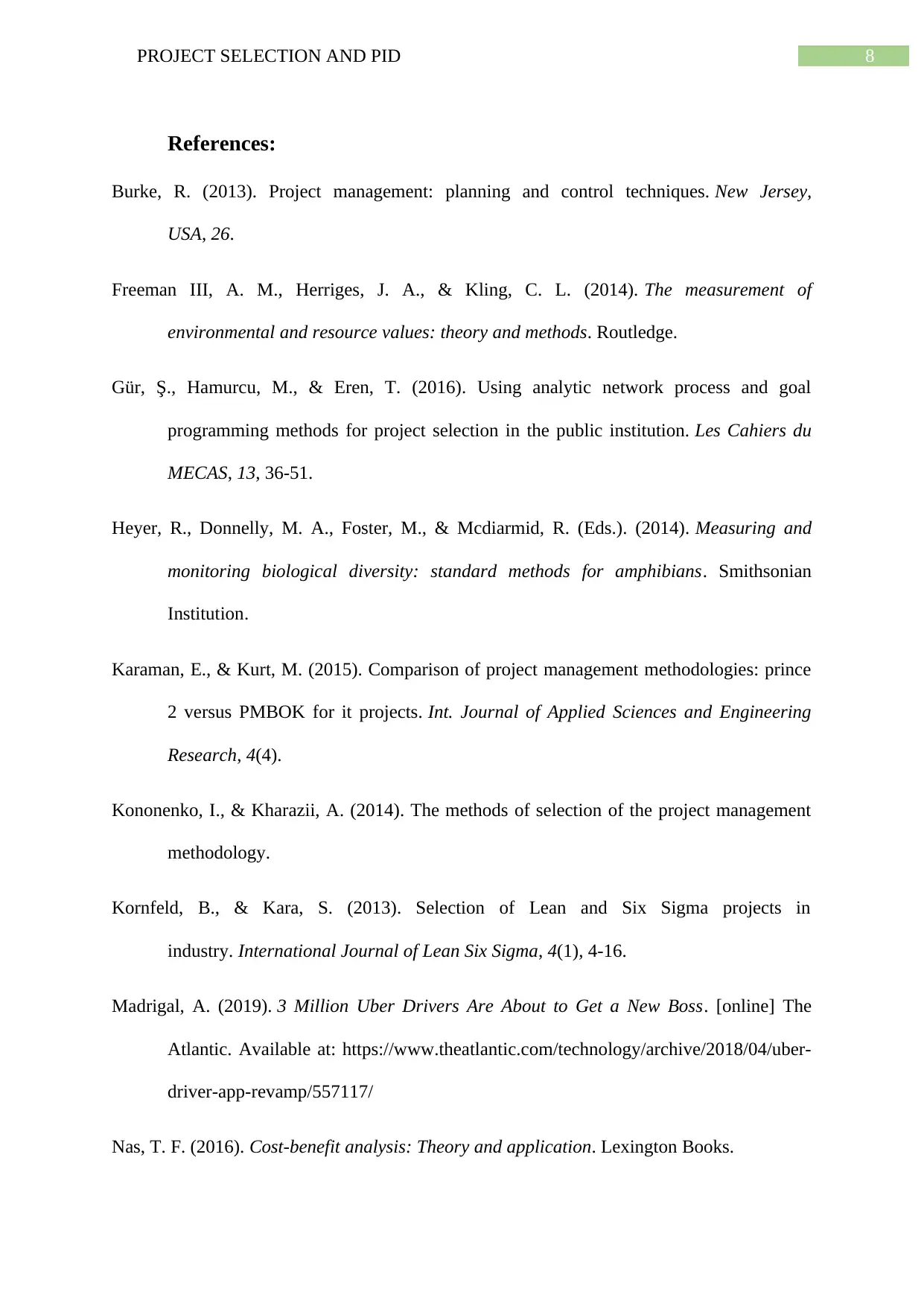
8PROJECT SELECTION AND PID
References:
Burke, R. (2013). Project management: planning and control techniques. New Jersey,
USA, 26.
Freeman III, A. M., Herriges, J. A., & Kling, C. L. (2014). The measurement of
environmental and resource values: theory and methods. Routledge.
Gür, Ş., Hamurcu, M., & Eren, T. (2016). Using analytic network process and goal
programming methods for project selection in the public institution. Les Cahiers du
MECAS, 13, 36-51.
Heyer, R., Donnelly, M. A., Foster, M., & Mcdiarmid, R. (Eds.). (2014). Measuring and
monitoring biological diversity: standard methods for amphibians. Smithsonian
Institution.
Karaman, E., & Kurt, M. (2015). Comparison of project management methodologies: prince
2 versus PMBOK for it projects. Int. Journal of Applied Sciences and Engineering
Research, 4(4).
Kononenko, I., & Kharazii, A. (2014). The methods of selection of the project management
methodology.
Kornfeld, B., & Kara, S. (2013). Selection of Lean and Six Sigma projects in
industry. International Journal of Lean Six Sigma, 4(1), 4-16.
Madrigal, A. (2019). 3 Million Uber Drivers Are About to Get a New Boss. [online] The
Atlantic. Available at: https://www.theatlantic.com/technology/archive/2018/04/uber-
driver-app-revamp/557117/
Nas, T. F. (2016). Cost-benefit analysis: Theory and application. Lexington Books.
References:
Burke, R. (2013). Project management: planning and control techniques. New Jersey,
USA, 26.
Freeman III, A. M., Herriges, J. A., & Kling, C. L. (2014). The measurement of
environmental and resource values: theory and methods. Routledge.
Gür, Ş., Hamurcu, M., & Eren, T. (2016). Using analytic network process and goal
programming methods for project selection in the public institution. Les Cahiers du
MECAS, 13, 36-51.
Heyer, R., Donnelly, M. A., Foster, M., & Mcdiarmid, R. (Eds.). (2014). Measuring and
monitoring biological diversity: standard methods for amphibians. Smithsonian
Institution.
Karaman, E., & Kurt, M. (2015). Comparison of project management methodologies: prince
2 versus PMBOK for it projects. Int. Journal of Applied Sciences and Engineering
Research, 4(4).
Kononenko, I., & Kharazii, A. (2014). The methods of selection of the project management
methodology.
Kornfeld, B., & Kara, S. (2013). Selection of Lean and Six Sigma projects in
industry. International Journal of Lean Six Sigma, 4(1), 4-16.
Madrigal, A. (2019). 3 Million Uber Drivers Are About to Get a New Boss. [online] The
Atlantic. Available at: https://www.theatlantic.com/technology/archive/2018/04/uber-
driver-app-revamp/557117/
Nas, T. F. (2016). Cost-benefit analysis: Theory and application. Lexington Books.
⊘ This is a preview!⊘
Do you want full access?
Subscribe today to unlock all pages.

Trusted by 1+ million students worldwide
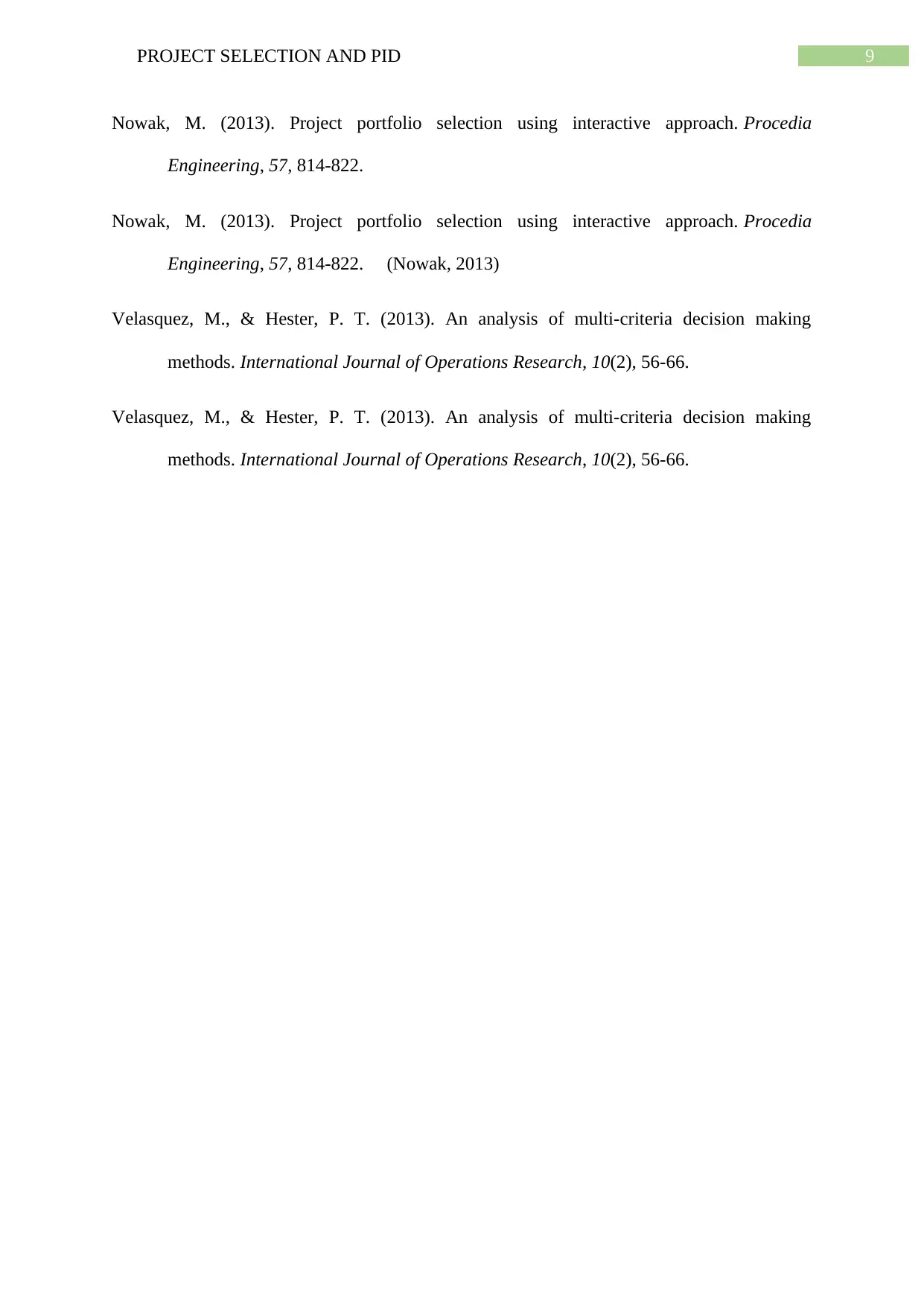
9PROJECT SELECTION AND PID
Nowak, M. (2013). Project portfolio selection using interactive approach. Procedia
Engineering, 57, 814-822.
Nowak, M. (2013). Project portfolio selection using interactive approach. Procedia
Engineering, 57, 814-822. (Nowak, 2013)
Velasquez, M., & Hester, P. T. (2013). An analysis of multi-criteria decision making
methods. International Journal of Operations Research, 10(2), 56-66.
Velasquez, M., & Hester, P. T. (2013). An analysis of multi-criteria decision making
methods. International Journal of Operations Research, 10(2), 56-66.
Nowak, M. (2013). Project portfolio selection using interactive approach. Procedia
Engineering, 57, 814-822.
Nowak, M. (2013). Project portfolio selection using interactive approach. Procedia
Engineering, 57, 814-822. (Nowak, 2013)
Velasquez, M., & Hester, P. T. (2013). An analysis of multi-criteria decision making
methods. International Journal of Operations Research, 10(2), 56-66.
Velasquez, M., & Hester, P. T. (2013). An analysis of multi-criteria decision making
methods. International Journal of Operations Research, 10(2), 56-66.
Paraphrase This Document
Need a fresh take? Get an instant paraphrase of this document with our AI Paraphraser
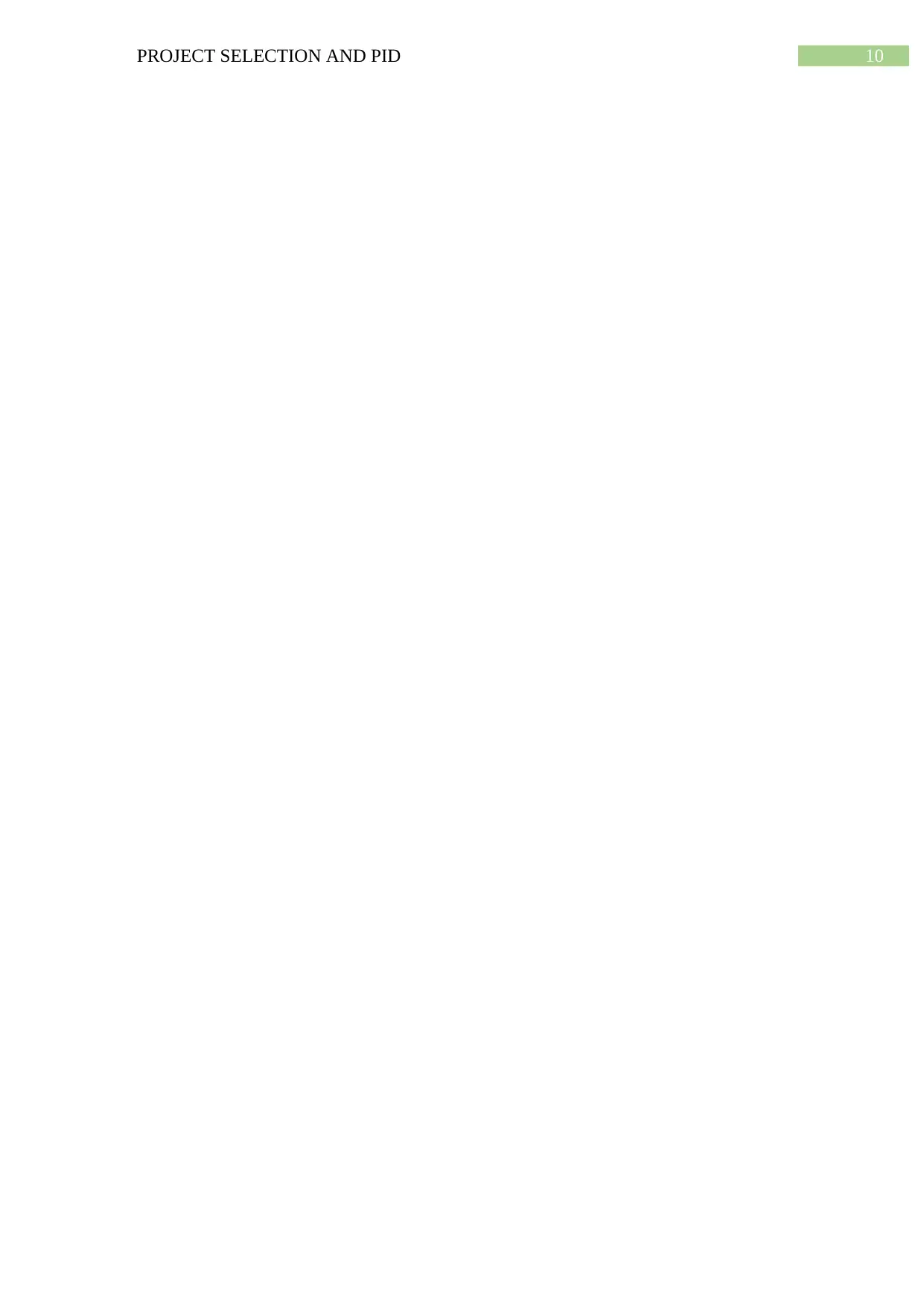
10PROJECT SELECTION AND PID
1 out of 11
Related Documents
Your All-in-One AI-Powered Toolkit for Academic Success.
+13062052269
info@desklib.com
Available 24*7 on WhatsApp / Email
![[object Object]](/_next/static/media/star-bottom.7253800d.svg)
Unlock your academic potential
Copyright © 2020–2025 A2Z Services. All Rights Reserved. Developed and managed by ZUCOL.



